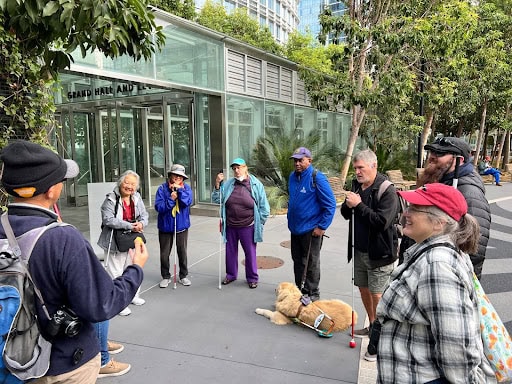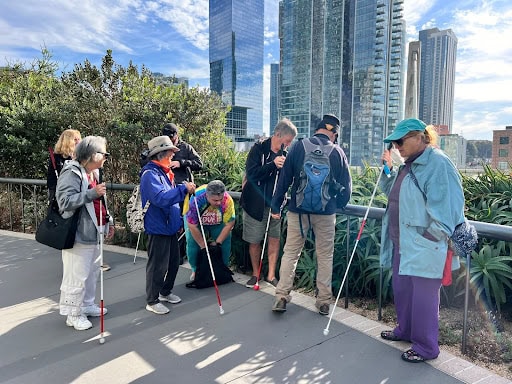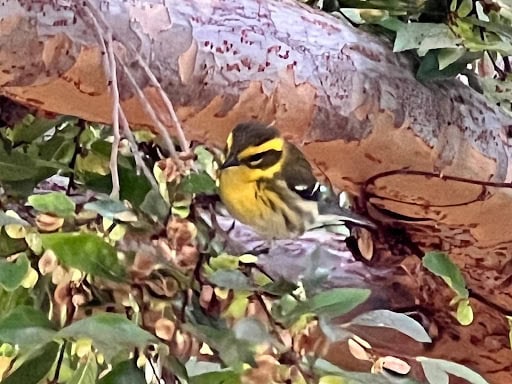Ear Birding with LightHouse for the Blind and Visually Impaired
By Helen Doyle, Jeanette Pettibone, and Daniel Scali
Dan interrupted us halfway around our introductory circle. “Did you hear that?” Several people had heard the bird chipping nearby. For those who didn’t, Dan tried to orient the group: “Off to the left, a little in front of me.” We remained quiet, listening for the chip notes. Golden Gate Bird Alliance’s (GGBA)s first birding field trip with Lighthouse for the Blind and Visually Impaired, an organization that “promotes independence, community, and equity created by and with blind and low vision people,” took place on October 25, 2024 during Birdability Week. It all started with listening.

Listening can be a challenge at Salesforce Park, an urban rooftop park located in the busy SOMA neighborhood of downtown San Francisco. Although it’s four stories above the street, the sound of trucks, buses, and sirens below forced us to concentrate in order to block out background noise. Despite the noise, trip leaders Dan Scali and Jeanette Pettibone chose this birding hotspot for its central location, accessibility, and ability to bring in other sensory experiences. The flat, wide, paved path that loops the park is bordered by a waist-high railing with a wealth of plants native to California and other Mediterranean climates within reach. This offered opportunities for the participants to feel, smell, and for some, see, the leaves and flowers of the plants hosting birds.

Photo @ Helen Doyle
We identified 11 bird species, mostly by ear. The chip notes of a Yellow-rumped Warbler, the chattering of White-crowned Sparrows in a bush four feet in front of us, the electric buzz of Anna’s Hummingbirds flying overhead, the typewriter-like sounds of a Ruby-crowned Kinglet. As much as the sounds themselves gave a clue to the bird’s identity, so did the location. The sparrows stayed in the bushes or foraged for food on the grassy lawn. The Black Phoebe flew quickly over the lawn from its perch and back, catching flying insects in midair. The warblers stayed higher in the trees. For each bird, Dan and Jeanette described the sounds, location, behavior and appearance, including color, patterns, and size. Markings like crowns, eyebrows (on birds, called supercilia), eye-lines, and moustaches relate to the human face. A hummingbird can fit inside the palm of your hand when it is nearly closed; as you open your fingers, a warbler or a sparrow can fit; an American Robin or Mourning Dove could sit on your fully-open hand. Some of the group’s favorites were the descriptions of the ‘butter butt’ yellow-rump and masked Townsend’s Warblers.

Photo @ Helen Doyle
Describing birds,their locations, and behaviors out loud is valuable for any birding field trip. It’s best not to assume people are seeing or hearing the same thing. This is especially true for new birders. For most of the eight participants, this was one of their first times birding. There were many great questions: why do birds sing, how do they learn to sing, what do they eat, which plants do they favor, and why do they behave in certain ways?
After traveling around the park, the group sat in the Barebottle Beer Garden to discuss questions that came up during the morning’s exploration. We also had a chance to learn more about bird anatomy, thanks to the tactile drawings of a bird created by LightHouse’s MAD (Media and Accessible Design) Lab for this field trip.

A tactile drawing of a bird’s anatomy from LightHouse’s MAD (Media and Accessible Design) Lab. Photo @ Helen Doyle
Because October lands in the fall migration period, Jeanette and Dan also shared information about bird migration, including strategies to support its safety, such as turning off lights in the evening, bird safe windows, and ways to turn your backyard or container garden into a refuge for a migrating bird. Above all, the group seemed especially interested to hear that many bird species migrate at night using an ability to ‘see’ magnetic fields.
GGBA and LightHouse plan to continue this collaboration with more birding field trips and events. If you’d like to stay informed about possibly joining ear birding field trips with LightHouse, send an email to Jeanette Pettibone (jpettibone@goldengatebirds.org).
Dan Scali has been birding for 20 years. Last spring he co-taught a class through GGBA on Birding By Ear in San Francisco. Formerly, he taught orientation and mobility, broadly, navigation for daily life,to blind and low vision youth. He currently works in bilingual education at the California Academy of Sciences.
Jeanette Pettibone met Sheri Albers, the Community Outreach Specialist for LightHouse, at an event coordinated by Helen Doyle at the San Francisco Botanical Gardens. Jeanette talked about birds (of course) and Sheri said she was interested. With the support of GGBA and LightHouse, a project was born. Jeanette also teaches classes through GGBA on Bay Area habitats and their birds.
Helen Doyle is a California Naturalist and educator dedicated to the environment, public education, and equity. A biologist by training, she shares her love of nature as a docent and writer. Helen serves on the advisory council of Nature in the City, a San Francisco nonprofit that connects people to nature, and represents Nature in the City on the Reimagining San Francisco steering committee and the SF Crosstown Trails coalition.
Additional Resources
https://www.audubon.org/birding-by-ear
Bird Songs of the Bay Area: https://openspacetrust.org/bird-songs/
Birdability Week: https://www.birdability.org/birdability-week-2024
Free course: https://www.birdscanada.org/online-courses/birding-by-ear-for-all
Descriptions: https://tpwd.texas.gov/events/great-texas-birding-classic/tournament-advice/blind-birders-tip-sheet
https://www.audubon.org/news/how-you-can-help-make-birding-more-welcoming-and-inclusive
Articles
https://www.nytimes.com/interactive/2023/08/03/style/birding-blind-low-vision.html
https://www.audubon.org/news/birding-blind-open-your-ears-amazing-world-bird-sounds
